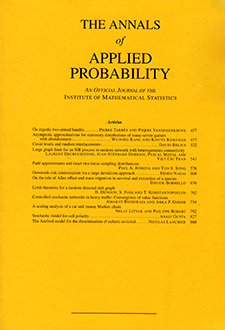Abstract
A complete solution is provided to the infinite-horizon, discounted problem of optimal consumption and investment in a market with one stock, one money market (sometimes called a "bond") and proportional transaction costs. The utility function may be of the form $c^p/p$, where $p < 0$ or $0 < p < 1$, or may be $\log c$. It is assumed that the interest rate for the money market is positive, the mean rate of return for the stock is larger than this interest rate, the stock volatility is positive and all these parameters are constant. The only other assumption is that the value function is finite; necessary conditions for this are given. In the Appendix (by S. Shreve), the sensitivity of the value function under the assumption $0 < p < 1$ is shown to be of the order of the transaction cost to the 2/3 power. This implies that the liquidity premium associated with small transaction costs is also of the order of the transaction cost to the 2/3 power. Because this power is less than 1, the marginal liquidity premium turns out to be infinite. The analysis of this paper and its Appendix relies on the concept of viscosity solutions to Hamilton-Jacobi-Bellman equations. A self-contained treatment of this subject, adequate for the present application, is provided.
Citation
S. E. Shreve. H. M. Soner. "Optimal Investment and Consumption with Transaction Costs." Ann. Appl. Probab. 4 (3) 609 - 692, August, 1994. https://doi.org/10.1214/aoap/1177004966
Information





